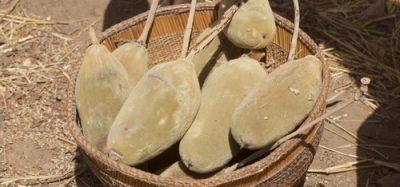One year on from the Australia-UK Free Trade Agreement
- Like
- Digg
- Del
- Tumblr
- VKontakte
- Buffer
- Love This
- Odnoklassniki
- Meneame
- Blogger
- Amazon
- Yahoo Mail
- Gmail
- AOL
- Newsvine
- HackerNews
- Evernote
- MySpace
- Mail.ru
- Viadeo
- Line
- Comments
- Yummly
- SMS
- Viber
- Telegram
- Subscribe
- Skype
- Facebook Messenger
- Kakao
- LiveJournal
- Yammer
- Edgar
- Fintel
- Mix
- Instapaper
- Copy Link
Posted: 7 May 2024 | Nick Sherwood, Stephen Edwards | No comments yet
Here, Nick Sherwood and Stephen Edwards explain how UK foodservice operators have been embracing Australian red meat as a high-quality, sustainable alternative to other imported beef and lamb options from around the world.


By Nick Sherwood and Stephen Edwards
In the 12 months since the historic Australia-UK Free Trade Agreement (A-UK FTA) came into force, unlocking 20,600MT of tariff-free exports for Australian beef and 14,700MT for sheep meat, Australian red meat imports have grown steadily, finding a complementary place alongside UK offerings in foodservice and on retail shelves.
Brand Aussie Beef & Lamb and Meat & Livestock Australia’s (MLA) Business Manager – UK, Stephen Edwards, said the A-UK FTA “had set a place at the table” for Australian red meat alongside local and imported red meat products.
“With the UK currently importing about one-third of the red meat that ends up on its tables, Aussie beef and lamb will over time aim to service a portion of the 400,000 tonnes of beef and 80,000 tonnes of sheep meat that is already imported into the UK each year,” explained Edwards.
“UK consumers have embraced Australia’s consistent and trusted red meat products as another high-quality product that is raised in a way that cares for our land and animals, with the integrity systems to back it up.
“As demonstrated over the past 12 months, Australia’s predominantly grassfed herd and consistent supply of highly marbled grainfed cattle, makes it well-positioned to meet growing UK consumer demand.”
Since the A-UK FTA entered into force in May 2023, grainfed beef exports have increased from a total of 600t in June 2022 to March 2023 to 1400t in 2023-24. For the same period, grassfed beef exports increased from 32t to 1750t, while sheep meat exports grew from 7000t to 12,500t.
“This growth tells us that while exports from Australia to the UK are increasing, we’re still only accounting for a small proportion of the total volume of red imported by the UK,” continued Edwards.
“It’s important to keep in mind that we started from a very low base compared to other countries like Ireland, Poland and the Netherlands and our growth will remain steady.
Feedback from Australian exporters consistently indicates that UK demand for Australian red meat is currently outstripping supply as demand from other established high-value markets holds firm.
“The trade deal opens the door for Australia to offer a greater variety of both beef and lamb to UK foodservice and retail operators, but strong demand and pricing in markets such as the US, Japan, Korea, and China is balancing the gradual increase of Australian red meat products entering the UK,” Stephen said.
JBS Global Managing Director, Nick Sherwood said the exporter had seen an “uptick in demand” across all of its Australian meat products.
“When the trade agreement went live, we saw many customers from different market channels asking for additional product,” Nick said.
“Prior to the A-UK FTA we had a number of lamb customers who we could regularly supply for only six to nine months of the year because of quota restrictions, whereas now we can maintain that supply all year round.
“Of course, our Australian lamb products trade in the global market so the UK has to be competitive vs alternatives, but the A-UK FTA allows us to develop deeper partnerships with UK customers, providing reliable, consistent quality lamb to service their market channels. Volumes are definitely up year-on-year.
“Beef has taken a little longer to rebuild to the UK, but it is steadily increasing across both grass and grain-fed products and market demand has been particularly pleasing. The wholesale and foodservice channels hold Australian beef in particularly high regard, and we know our customers’ feel confident using Australian beef for its consistent eating quality, which also helps grow their businesses and in turn creates greater demand for Aussie beef and lamb.”
Consistently safe and high-quality red meat
Retailers and foodservice operators can be confident that when they plate up Australian red meat it will meet their customers’ expectations every time, as guaranteed by the world-class meat grading programme, Meat Standards Australia (MSA). Many Australian beef brands are underpinned by the MSA grading system.
Stephen said the MSA programme guarantees that cattle are raised, handled, and processed in a way that ensures the best outcomes for the animals and the beef purchased.
“All MSA beef is graded and assigned an eating quality score, backed by decades of science and more than 1 million consumer taste tests from 11 countries,” he said.
“When you purchase Australian beef, you can be sure you’re getting the quality and integrity you’re paying for.”
Australia’s adherence to the European Union Cattle Accreditation Scheme (EUCAS) also ensures all beef coming to the UK is free of hormone growth promotants, verified through full traceability of all animals through the National Livestock Identification System (NLIS), which links individual animal IDs to a national database.
It also assures British consumers that Australian livestock meets the specified antibiotic requirements set out by EUCAS.
Additionally, the Australian Government’s strict NLIS biosecurity and traceability regime for red meat exports sets it apart from other global red meat competitors.
“Australian beef and lamb is an excellent option for foodservice, retail operators and consumers keen to try a wider range of products,” Stephen said.
“Known for its extended shelf life and stringent export standards, Aussie red meat offers more high-quality choices and flexibility that is guaranteed to satisfy your expectations, every time.”
About the authors:
Nick Sherwood is the JBS Global Managing Director. He has worked in the global meat industry for nearly 30 years, starting in NZ but with stints in Japan, USA, Europe and UK. Nick has worked in the UK/EU market for over 20 years. The past 14 years have been with JBS based in London. The JBS business handles many different origins and proteins, but Australian beef and lamb are a significant part of the business for UK supply.
Stephen Edwards is Aussie Beef & Lamb and Meat & Livestock Australia’s (MLA) UK Business Manager. He is a professional marketeer who has been working in the food industry internationally for over 40 years.Now based in London at Australia House, he is the UK Business Manager for Meat & Livestock Australia, managing the introduction of the Aussie Beef & Lamb brand into the UK market.His wide and varied role has been developed to assist the Australian red meat industry to increase the value of Australian beef and lamb in the UK,with the Free Trade Agreement now in place.









